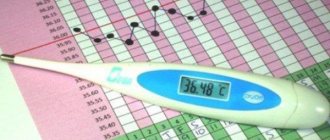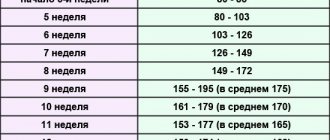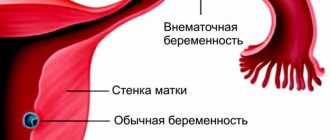Basal temperature is the body temperature at rest, when it is possible to calculate the state of the gonads and the system as a whole. It shows the lowest temperature readings, which are observed only at rest. This helps many women understand what phase they are in. Correct measurements and schedule during the cycle help determine the period of ovulation when you can conceive a child or, conversely, have unprotected sex without consequences.
There are three successive phases of the menstrual cycle:
- Follicular.
- Ovulation.
- Luteal.
At each stage there is a different level of hormones, which is reflected in the basal temperature. To obtain accurate data, it is necessary to take accurate measurements in the rectum, vagina, or mouth.
Measuring rules
The main rules of measurement, which are noted on the website ogrippe.com, are as follows:
- Take your temperature no more than 30-60 minutes after waking up.
- The duration of sleep before measurements should be at least 3 hours. A shorter rest period may skew the results.
- Take measurements at the same time.
- Take your temperature while lying down, do not sit down.
If you take the temperature later, you may make a mistake. Notes should be made in the records at what time the measurements were taken. Every hour the temperature increases by 0.1 degrees.
The same thermometer should be used throughout the entire cycle to obtain more accurate data. It is better to use a digital thermometer that makes a sound when the measurement is completed. However, when using a mercury thermometer, you should hold it for 5 minutes. At the same time, it is not advisable to rise or move suddenly.
It is better to take measurements throughout the month, including monthly days, in order to create a schedule.
go to top
Rules for measuring basal temperature
Basal temperature is the temperature of the internal environment of the body, which is less dependent on changes in the environment. It is customary to measure temperature orally (in the mouth), vaginally (in the vagina) or rectally (in the anus, rectum). Doctors recommend the latter method as the most reliable.
To obtain correct data on the functioning of the ovaries and the possibility of conception, you must adhere to several rules. Temperature is measured:
- lying in bed, immediately after waking up, before visiting the toilet and any vigorous activity, preferably even without turning on the light;
- at one time - the range is no more than 30 minutes, because every hour of sleep changes the displayed number by 0.1°;
- one thermometer - the readings of different devices may not coincide;
- in one way - you cannot alternate oral, vaginal and rectal measurement methods within one cycle.
Temperature readings can be influenced by many factors. Data changes are facilitated (not always):
- drinking alcohol the night before;
- intimate intimacy at night less than 3 hours before measurement;
- insomnia – sleep duration less than 3 hours before the procedure;
- taking certain medications - when receiving a prescription from a doctor, you should clarify how these drugs affect basal temperature;
- flight, travel, vacation at sea and other acclimatization moments;
- serious stressful situation (single-stage or long-term).
Therefore, it is necessary to make notes on the chart sheet. In this case, when analyzing the temperature curve, some inconsistencies can be neglected, while others will remain indicative.
BT schedule
The basal temperature (BT) chart is drawn from the beginning of the last to the beginning of the new menstruation and then a new one is drawn. The dividing line is the period of ovulation, when the egg is released from the ovary. She divides the stages into before and after. Ovulation occurs in the middle of the menstrual cycle - on days 12-16.
The average cycle length is 28 days. This is the period from the start of bleeding of the previous menstruation to the first day of bleeding of the next. In some cases, this period increases to 35 days. Sometimes the last point in the BT chart is 21 days.
go to top
First phase
The follicular first phase is also called hypothermic, while the luteal phase is hyperthermic. From the names it becomes clear that in the first period the body temperature is slightly lower, and in the second – increased. In the follicular phase, a follicle is formed in which the egg matures. Estrogen is produced by the ovaries. The normal temperature during this period is up to 37°C. This is favorable for pregnancy.
Elevated temperatures during this period become the reasons why conception does not occur. If in the first phase the temperature remains at 37 degrees, and the basal temperature on the 17th day reaches 37.5 degrees, then insemination becomes problematic, even if the sperm has penetrated the female reproductive system.
go to top
Second phase
Ovulation is difficult to detect. In the second phase, the temperature decreases, and the next day it increases by 0.4-0.5 ° C. She stays like this until her period. On average, the second phase lasts 14 days.
A decrease in basal temperature during implantation indicates the activation of estrogen - hormones that affect the temperature inside the reproductive system. This decrease occurs for several hours, and then increases again.
The duration of the luteal phase can be short - 10-12 days, which indicates its insufficiency and inability to bear a fetus. A longer phase may indicate the appearance of a cyst in the corpus luteum or the beginning of pregnancy. Only a doctor can decipher the data.
Ovulation occurs somewhere in the middle of the cycle. Sometimes it may not happen at all. Its presence is indicated by an increase in temperature.
go to top
Temperature data tracking
Tracking the correct sequence of phases in the cycle allows you to most likely plan a pregnancy and implement the plan or avoid unwanted conception.
The following indicators are characteristic of a well-functioning sexual sphere of a woman:
- after menstruation (more precisely, from the 2nd - 3rd day of the first phase), the basal temperature is set at a slightly lower level - 36.2 - 36.5°C;
- after the release of the egg (in the middle of the cycle), there is a noticeable increase to 37 ° C or slightly higher (luteal phase);
- at the end of the first phase, 1 - 2 days before ovulation, a one-day decline in indicators is noted (0.1 - 0.2 ° C);
- before menstruation and at the beginning of menstruation, the temperature remains at the level of the second phase, and then decreases, a new cycle begins - if during menstruation the numbers do not fall, then, most likely, conception has occurred, the fertilized egg has implanted and pregnancy develops.
Important! With a natural method of contraception based on the timing of ovulation, in the first phase of the cycle it is recommended to take additional protective measures, because The maturation of the egg does not always occur at the same time.
Read also:
Varicose veins during pregnancy: types, symptoms, treatment
Indicators in the first phase
In the first phase, estrogens predominate, which control the temperature of the reproductive system. Normal values are 36.2-36.5°C. If during this period the temperature rises to 36.5-36.8 ° C, then this indicates insufficient estrogen levels. In this case, gynecologists prescribe hormone therapy.
If the increase in temperature during the follicular period occurred within one day, then you should not worry. No pathologies can occur during such a period. Deviations should be judged not by a single indicator, but by the entire schedule, which is drawn up many times.
go to top
Indicators in the second phase
The second phase can also be marked by high temperatures. This indicates estrogen deficiency. After the egg leaves the follicle, the temperature rises to 37°C or more, which interferes with conception. The mark of 36.8 degrees is observed very rarely.
Rectal measurements exceed those in the first phase by 0.4 degrees. This is considered normal. Less significant differences indicate problems that need attention.
Every woman's body is unique. He is not required to meet clear indicators. Sometimes a high or low temperature is a feature, not a disease. Measurement methods should also be taken into account. Differences of 0.2 degrees are quite normal.
go to top
Impact factors
It is necessary to take into account factors influencing BT indicators. They are:
- Drinking alcohol.
- Sexual relations before dawn or at night.
- Inflammation in the leg area.
- Stress.
- Various diseases.
- Sleeping with a heating pad under an electric blanket.
These factors should be noted in your notebook where you keep your BT chart. Gynecologists advise taking daily measurements for at least 3 months, which will help identify more accurate data and features.
If a woman wants to more accurately determine the day of ovulation, then she should take daily measurements and write them down in a notebook for six months, or better yet, a year. In this case, you should stop taking hormonal medications and the contraceptive device. Only the use of a condom is allowed.
go to top
Rising temperature as an indicator of pregnancy
All manipulations are done for the sake of conception. A rising temperature may be an indicator that pregnancy has begun. This becomes clear when, from the moment of ovulation until the onset of menstruation (when they should begin), a high temperature is noted. It rises to 37°C or more and does not subside. This indicator becomes unambiguous if such a high temperature is noted in the period before the onset of menstruation and its delay.
In the second phase, BT can also be high in the absence of pregnancy. It rises to 37 degrees and above and stays there. Its decrease occurs the day before the start of menstruation. Accordingly, if there is a delay and BT is high, then we can talk about pregnancy. Therefore, you should focus not only on pregnancy tests, but also on internal temperature indicators.
Gynecologists recommend waiting for a delay so that breast disease and high temperature before menstruation are not misleading. These factors are normal before normal menstruation. However, a delay in combination with such symptoms may already indicate the beginning of pregnancy.
go to top
Temperature indicators in normal and pathological conditions
Particular attention should be paid to the following indicators:
- The temperature difference between phases 1 and 2 of the cycle should be greater than 0.3°. In this case, even hundredths are taken into account (not less than 0.33). This, and not absolute numbers, is important in determining health.
- Temperature before menstruation:
- if the temperature before menstruation is 36° with a slight tail, conception has not occurred, there are problems with the release of progesterone in the second phase;
- if the temperature before menstruation is 37° or slightly higher, the hormonal levels are normal, it is quite possible that conception has occurred, which will become clear in a few days;
- if the temperature before menstruation is 38°, there is a very high probability of inflammation in the genital organs, you need to visit a gynecologist.
Read also:
What can lead to the threat of miscarriage in the early stages and what treatment can be prescribed
If conception is planned, the ovulation schedule is normal, contraception is not applied, and pregnancy does not occur, then both partners are examined. Modern methods of identifying factors that reduce fertility give the best results when working with a couple, and not just with a woman.
Thus, regularly measuring basal temperature is a useful skill that can provide basic information about women's health and indicate possible problems in time. It can be practiced at any age after the onset of menstruation and before menopause. Many young ladies are already accustomed to such tracking of processes occurring in the body, and are planning to teach this to their daughters.
Temperature changes during other processes
You should listen to your body. A situation may arise when a change in temperature indicates other processes, for example, a miscarriage. In this case, menstruation is scanty and BT is high. You should take a pregnancy test and visit a gynecologist.
An increase in basal temperature on the 22nd day and its absence before or on the first day of menstruation may be an individual feature or indicate inflammatory processes in the body.
If BT drops on day 25, then this indicates upcoming menstruation. Everything in a woman’s body happens normally.
go to top
What is normal basal temperature in early pregnancy?
This question is relevant for a significant number of women who have a history of complications in the normal course of the process of bearing an embryo. All changes in a woman’s body that occur at this time are initiated by hormones. And basal temperature is an indicator of the amount of such hormones. And if their number decreases or increases, and their balance also changes, then the internal temperature will also change accordingly.
The normal basal temperature during pregnancy is 37 and two degrees (the minimum acceptable level is exactly 37). Its prolonged decline to at least 36 and 9 indicates an increased risk of miscarriage, and in order to prevent further development of the problem, it is necessary to visit a gynecologist (the use of the drug Duphaston may be necessary).
Basal temperature should be measured in order to control the amount of progesterone produced in women’s bodies in the first four months. Next, the hormone begins to be produced in the placenta, so BT will no longer be very informative.
In early pregnancy, it is BT that can indicate the birth of a new life. And this, with a careful analysis of the schedule, can be seen before the delay occurs. You need to know that such a change also occurs during inflammatory processes, increased physical activity and other factors. Therefore, an increase in BT is only an indirect sign of the beginning of the gestation period of the embryo.
If an elevated basal temperature in the early stages is normal, then a serious deviation in physiological hormonal levels can be suspected. If it is 36 degrees, then you can suspect an incipient miscarriage or other problems. one should be wary of such a temperature, because it indicates a sharp lack of the hormone progesterone, which is responsible for the course of the gestation period of the embryo. And urgent consultation with a doctor in such conditions is mandatory.
But even such cases are ambiguous. It is possible that the decrease in BT was affected by severe overwork, stress, etc. If the decrease in basal temperature occurred only once, then there is no need to worry, but it is also not advisable to ignore it. A woman who has noticed at least once a single drop in her temperature should carefully and carefully monitor this indicator every day.
The maximum BT level during pregnancy is 38 degrees. If this is detected, then you should contact a specialist. A temperature rise above 38 indicates that an infection is developing in the body. It is advisable to note that this indicator appears if a woman measures her body temperature incorrectly.
If a high temperature is recorded during menstruation, it is recommended to visit a doctor, because such a symptom is a sign of a hidden infectious process.
It is recommended to note that the lowest BT is detected after menstruation. It is highest before menstruation. And changes in this ratio can also indirectly indicate that a hormonal imbalance is occurring in the body.
By taking for yourself a sample graph of basal temperature by day of the normal cycle, you can familiarize yourself in advance with examples of the norm of basal temperature before, during and after menstruation.
Just 15 years ago, measuring BT was considered one of the main diagnostic methods for assessing women's reproductive health. After all, the basal temperature of a non-pregnant woman is fundamentally different from the BT of a pregnant woman. A “healthy” temperature chart is completely different from that of a girl with “feminine” problems.
Forecast
Basal temperature, of course, can help a woman determine the days of ovulation and even find out in advance that she is pregnant, but such indicators are not always unambiguous. The prognosis largely depends on a combination of many factors, not just resting body temperature.
The individual characteristics of the body should be taken into account. You can find out about them if you keep a BT chart for several months. Based on the indicators, it will become clear what is inherent in a particular female body at each phase and before menstruation. Also, you should not prematurely rejoice in pregnancy if BT is high before the onset of menstruation.
Various factors affect a woman's body. The seasonality of the year should be taken into account, which also affects the state of general health. After taking measurements for six months or a year, we can draw some conclusions. It is better to review the schedule with a gynecologist, who takes into account many factors. This will help either conceive a child or get rid of female problems that prevent you from getting pregnant.
What happens if pregnancy occurs at a low basal temperature?
If for successful conception it is necessary that the temperature be below 37 degrees, then for the further development of the embryo it is imperative that its level be slightly higher. In almost all pregnant women, in the first weeks after conception it remains at 37.
During ovulation, the basal temperature should be 37.1-37.3; a deviation from the norm by 0.8 degrees up or down is already an alarming signal. A low temperature indicates a deficiency in the corpus luteum phase, which is responsible for the production of progesterone.
The corpus luteum is a temporary gland, thanks to which the embryo in the first weeks of pregnancy receives all the necessary substances to maintain life.
Accordingly, even if pregnancy occurs at a low temperature, the fetus will not be able to survive.
Reasons for low BT after ovulation:
- Implant window.
- Estrogen and progesterone deficiency.
- The temperature was measured incorrectly.
- Alcohol, stress, jet lag.
- Individual norm.
The following signs may indicate a lack of progesterone in the blood:
- There is no decrease in BT before menstruation.
- The second phase is too short, less than 10 days.
If the basal temperature has decreased after ovulation, you must, firstly, eliminate errors when measuring BT, and then carefully study the graph. If there are deviations from the norm, you must first pass all the tests. If the results are within acceptable limits, then this basal temperature relates to the individual characteristics of the body.










